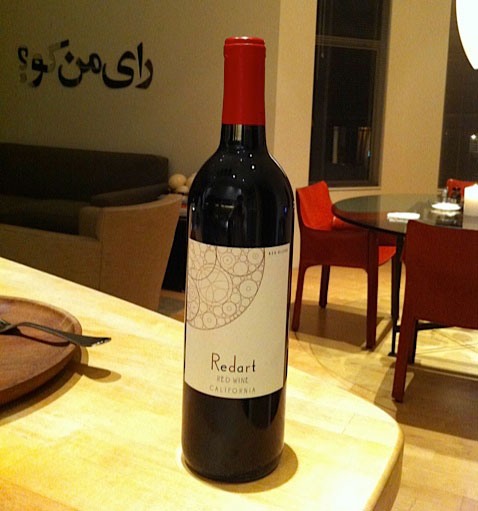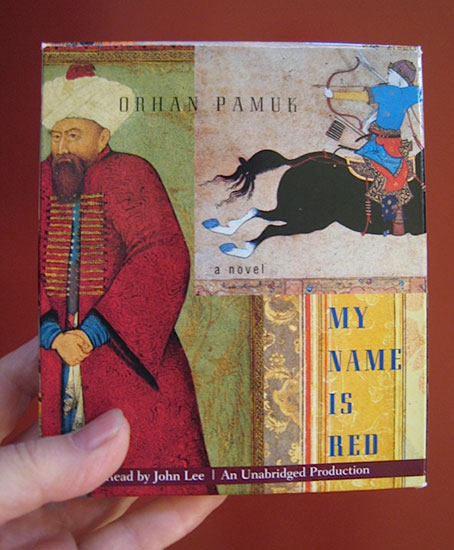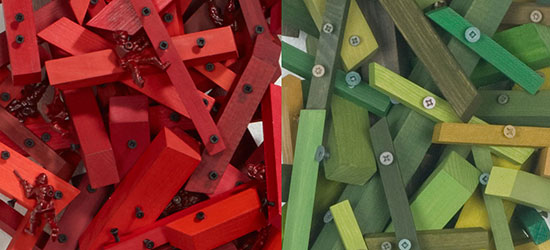Early in 2013, I was working in my studio in San Francisco on a commission for a collector using the beautiful small branches of deep purplish/red/brown California Manzanita. I decided to paint the slant cut ends of each twig piece in a color.
As I began to figure out what that color might be, I also began listening to Orhan Pamuk’s captivating, fascinating, informative and suspenseful murder mystery novel set in the 16th C, My Name Is Red. (16 discs 20.5 hrs.) Sometimes it is difficult to trace the provenance of specific details as they evolve in the studio, but toward the end of the book I realized that the “Turkish” red that I had chosen from my many test samples of color for the sculpture must have been suggested by Pamuk’s extraordinary novel. (During this period I was also listening constantly to the music of Otis Redding when not Pamuk’s story, so his music may have played a role in my subconscious decision making activity also.)
The Pamuk discs were given to me by a wonderful young British artist, Rebecca Taber, who was my studio assistant for a time before relocating to Southern France. When I emailed her that I was immersed in Pamuk, she responded, “it’s so symbolic in many ways. I loved the way there was a description of the clash between cultures seemingly so contemporary and yet never forgetting the period in the 1500’s when it is set. What a great studio partner! It’s so lovely to think of you there deep in Turkish red soaking up the streets of Istanbul whilst in San Francisco!” Reading Pamuk’s novel the reader will be immersed in feeling this extraordinary color and learning fascinating things about Turkey and art.
In Chapter 31 – “How exquisite it is to be red.”
I do love red, though I find it a difficult and tricky color. I am currently working on my second red “devil” question mark sculpture. I want a wide range of reds. I can mix seemingly unlimited variations of greens, but reds… even when carefully mixing, they start looking alike within very narrow ranges – all the deep reds start looking similar and all the orange reds start looking as if from the same mixture.
Red is powerful. Some while ago, as women began to be more prominent in politics, I noticed that more and more of them were wearing red. It struck me as strange to see the few reds among all the dark suit uniforms of the men. I did not like it. It was such a strong image showing us how few women there were in leadership roles. Then I began to dislike seeing women in red. More and more of the TV newscasters, CEO’s of companies and female pundits appeared in red. Red on television often vibrates! This is very distracting. There is no light red. Light red is pink. Pink, in my opinion, is an even worse color for women… and little girls… now ubiquitous in pink, shoes, princess dresses, back packs, purses, socks, etc. (thank you Disney!). Every other color I can think of can be presented in a light version, but not red (though, perhaps, black is an exception, as well, becoming grey – many think of grey as a separate color.)
Red for women is associated with erotic… being hot. We call women tomatoes. Red for hearts – blood red. Red for emotion. Red faced – blushing. Little Red Riding Hood. Red is powerful. Red is political. Red is distracting as no other color can be. It may, conversely, be as attracting as no other color can be.
And, from Pamuk I learned, red is not known, but felt…. And that is something I have always experienced when using it and why, I now realize, I like it so much.






Some Observations: On Light and Air
Recently I visited the Los Angeles County Museum of Art specifically to spend time immersed in the imagination of James Turrell whose retrospective covers fifty years of work exploring light, sky, perception, color, shape and architecture. http://www.lacma.org/art/exhibition/james-turrell-retrospective. The meditative quality of this exhibition encourages the viewer to be a considered observer and allow what they see and perceive to be altered by their physical experience with the work. Ultimately the transformative and ephemeral qualities of light exist in the mind of each person. The artist gives us the opportunity to bathe our senses in illusion and reflection.
The next day on a non-stop eastbound flight traveling in the morning from Los Angeles to Boston I was seated on the north side of the airplane and could view the magnificent snow covered Rocky Mountains below rising from the earth with the suggestion of a world without grief.
photo by Wendy Wahl
In the minutes that followed I found myself focused on the carbon footprint that air travel leaves and thinking about the best way to balance my personal footprint. Knowing for the moment “I am where I am” my gaze returned to the framed light as we swiftly moved above the fruited plains. I watched until somewhere over the Great Lakes the image through the oval-edged window changed into another remarkable illuminated landscape.
photo by Wendy Wahl
As a commercial airline passenger for over four decades I have encountered a wide range of situations and had experiences that touch on almost every imaginable emotion. Each flight has a unique dimension heightened by the sounds, sights, smells and physical proximity of the other passengers in a tightly enclosed space. The curious activity of moving at fast speeds from one environment to another, around and about what has become a very small sphere in a short period of time, stimulates thought about place, perception and the possibility of portals. Having flown on Pan Am, Continental, Delta, American Airlines, United Airlines, Laker Airways, Peoples Express, Southwest, British Airways, Hawaiian Air, TWA, Qantas, Virgin Australia, Aero Mexico, China Air, Alitalia, Air India, Lufthansa, Air France, JetBlue and a number of puddle jumpers – I’m feeling that of all these, Virgin America has created an illusion of a different sort for air travelers through the use of color and light.
Wendy Wahl
March 2014